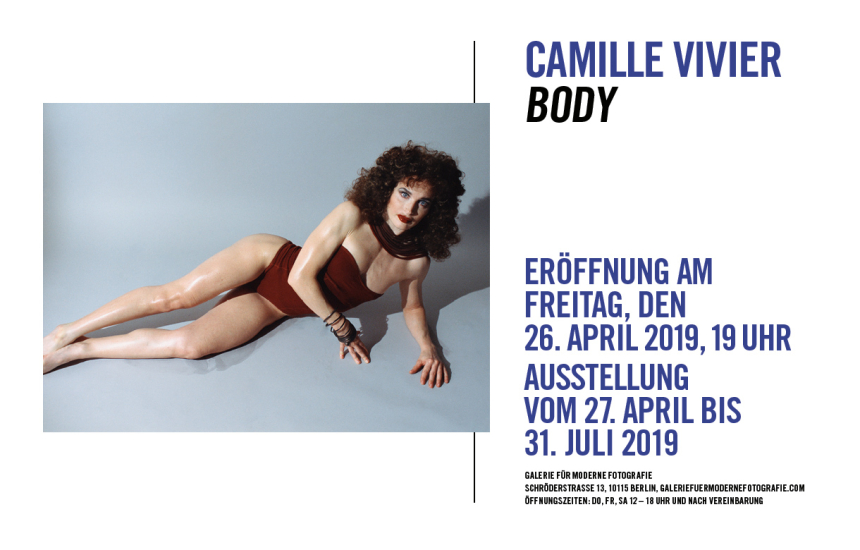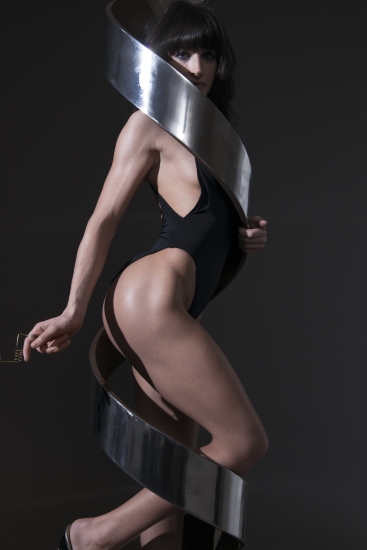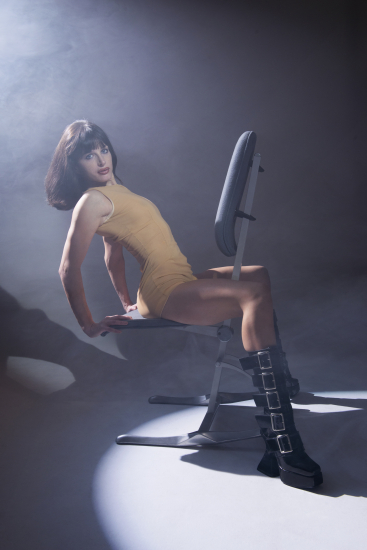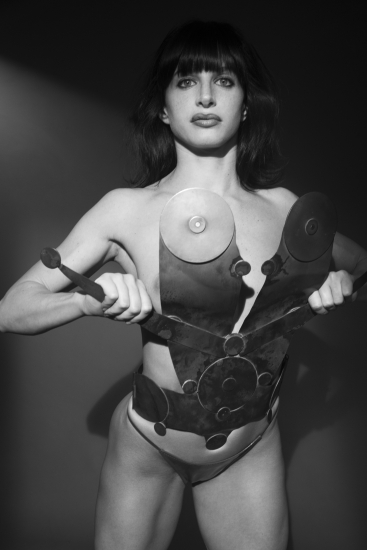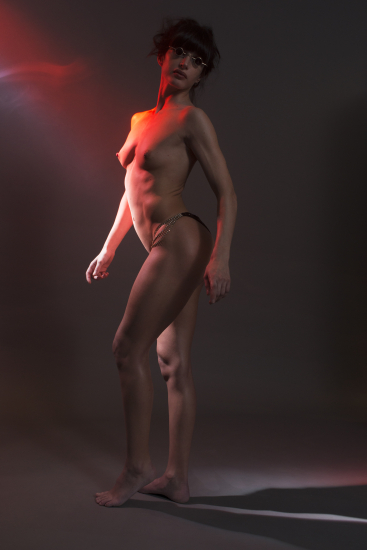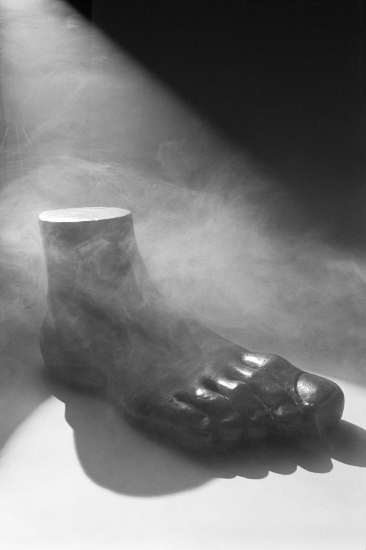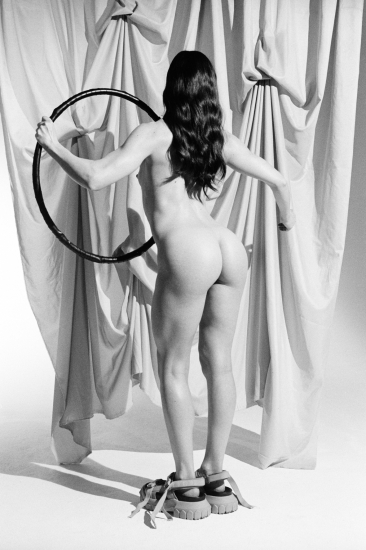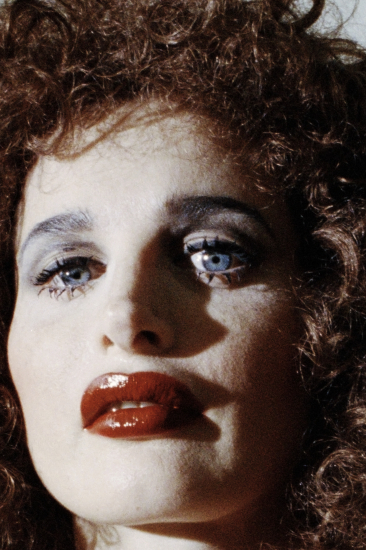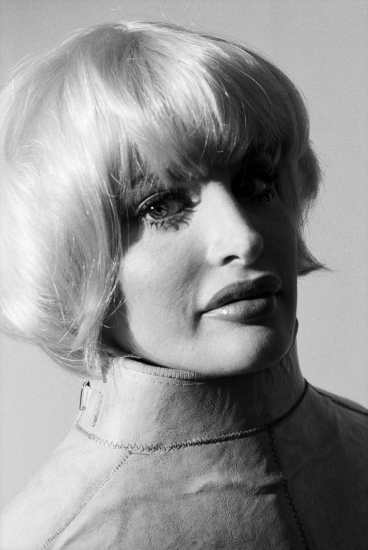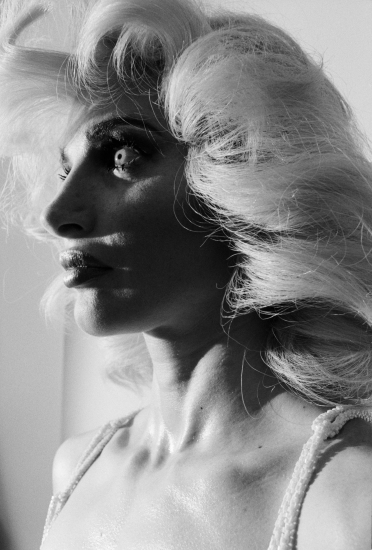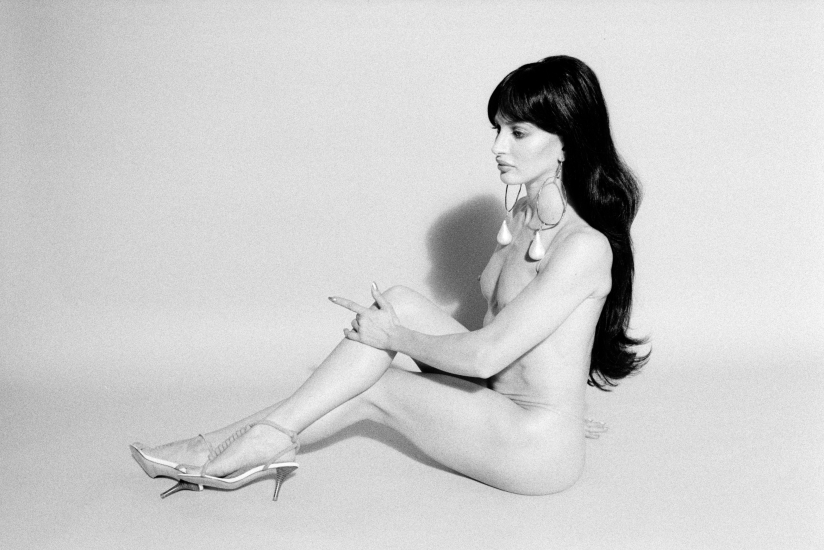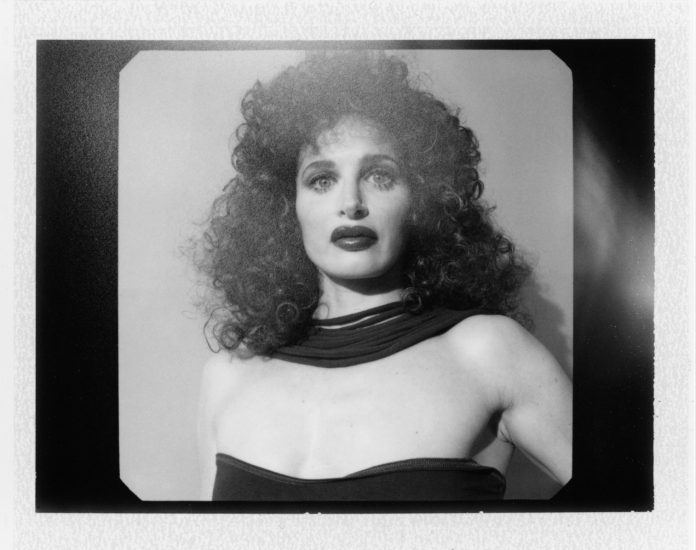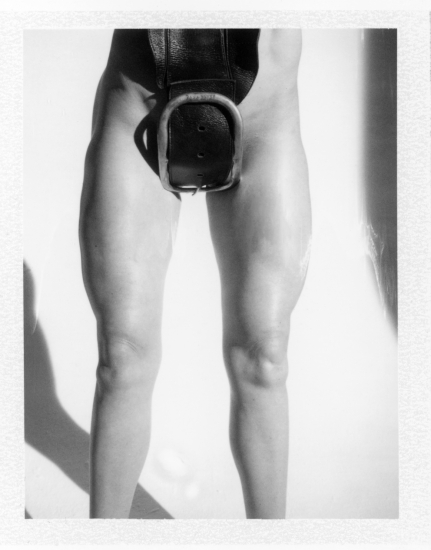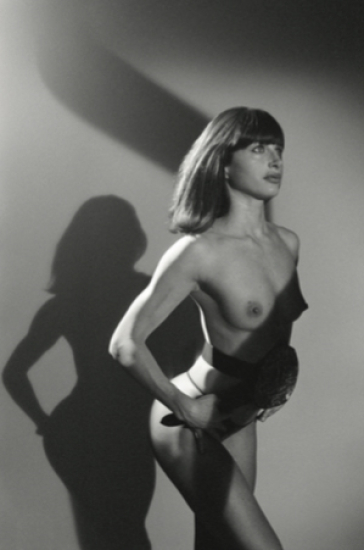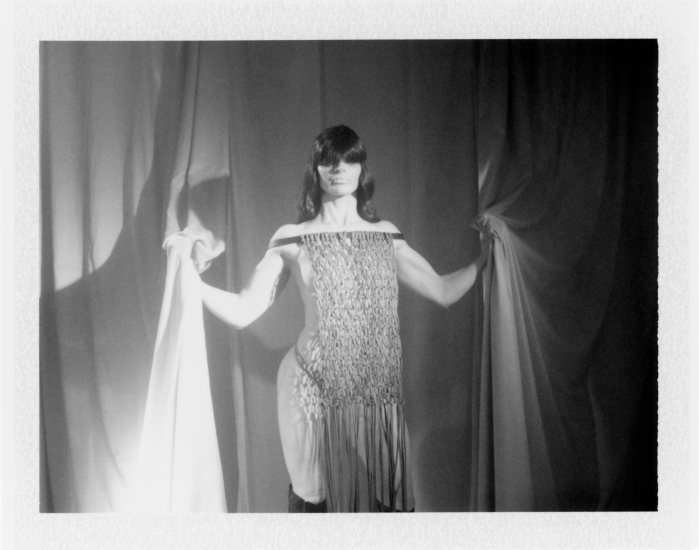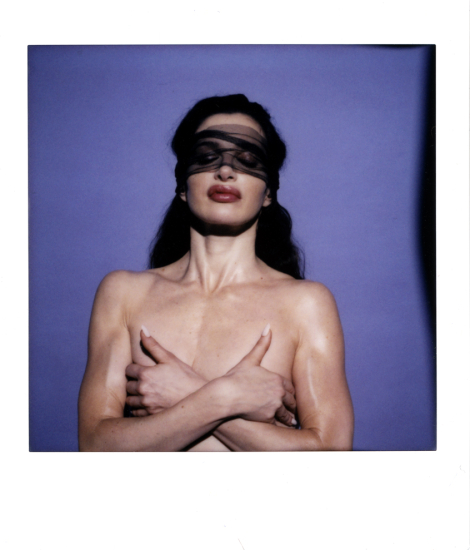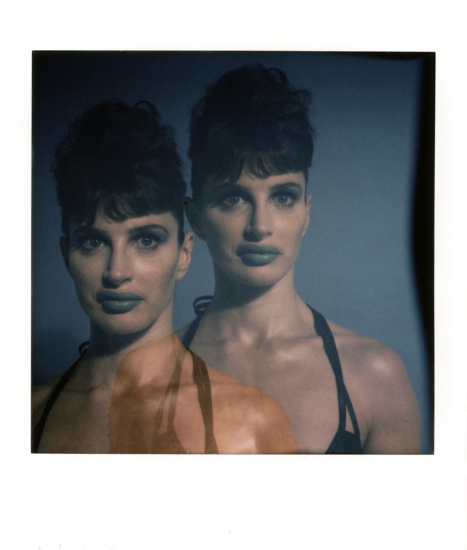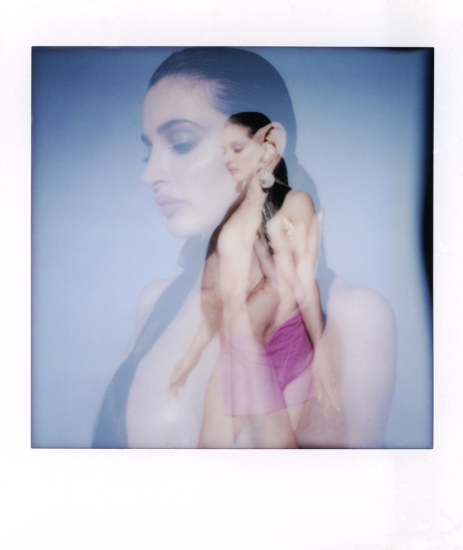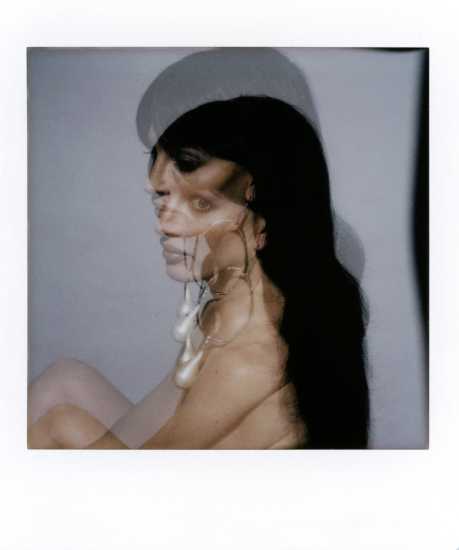A woman with curly red hair, blood-red lips, and a wine-red velvet swimsuit stands there looking at us. Her hands are clenched into fists, her waist is slightly tilted to one side, and her chest swells with pride. Her sharply defined arms and legs glow in the spotlight. The woman looks powerful. She looks like a super- heroine. One might even say a modern-day Wonder Women if not for her gaze. Her bright blue eyes reveal something other than the confident pose: a brokenness, a vulnerability.
This contrast between strength and fragility, maleness and femininity, is what fascinates French photographer Camille Vivier about Sophie, a professional bodybuilder who competes in the “Bikini Fitness” category. Anyone familiar with Vivier’s work will again recognize her very unique way of seeing in this series titled Body: her play with ambiguities, her passion for staging, her fascination with the female body. As well as the nostalgia that almost always resonates in her aesthetic. All of this is there. And then there is something else. Something new. Where the photographer previously depicted very natural, young female bodies, in particular in her investigations of the nude photography genre, here she explores the body of a thirty-seven-year-old woman who has created her own physical form. Like an architect creates a building, or a sculptor her stone: through bodybuilding, through cosmetic surgery.
Sophie’s forms have something very sculptural about them, says Vivier. Thus, none of the objects, not even architecture or any of the accompanying elements she usually prefers to include in a slightly surrealistic manner, are needed. She likes the contrast between animated and inanimate, subject and object, but Sophie’s body is, in a sense, already both. It is almost like a place, like a theater, which, depending on what is being performed, depending on the role it takes on, can be completely changed and rediscovered. Vivier finds this “absolutely fascinating.” And perhaps this is why she has focused on the same woman over a long period of time for the first time. She met Sophie less than three years ago while photographing her for a fashion magazine; she got back in touch with her almost a year ago. Since then almost fifty images have been created; eighteen of these will be featured in the exhibition.
The series, which will culminate in a book at the end of the year, is a portrait, not documentation. Sophie, the real Sophie, the woman she is in her everyday life, is not depicted in any of the images. Nothing is revealed about her personal life or how she develops her artificial body, about her muscles that are not immediately recognized as those of a bodybuilder—Vivier is not interested in this. Rather, she depicts what perhaps only a woman can see in a woman: specifically the freedom to be many women. To be allowed to reinvent yourself and your body, the impact it makes and its beauty, over and over again. Here, Camille Vivier is a bit like an author who tells a story, or rather a lot of stories, originating with one actual person. She sets out the potential lives, the different facets of her physique, stages them, almost in the manner of Cindy Sherman, like a director working with her actress.
The references she cites are from a time when women were required to be always perfect and happy: women such as the recently rediscovered American writer Lucia Berlin, the female characters of Rainer Werner Fassbinder or the fantastic Gina Rowlands, in particular through the eyes of her husband, John Cassavetes, who inspire her and who Sophie’s aura evokes. They are beautiful women, strong women, the kind who are proud and even a bit dangerous, but in whom one also senses something broken. A sadness shining through the highly poetic and uniquely beautiful mask she wears for society. Vivier’s portraiture succeeds in subtly highlighting this. When beginning the work she posed herself the question: “What can you, what are you allowed to find beautiful?” This exhibition is likely to provide an initial answer.
Text: Annabelle Hirsch
For further information, press inquiries and images please contact Kirsten Landwehr mail@galeriefuermodernefotografie.com
This contrast between strength and fragility, maleness and femininity, is what fascinates French photographer Camille Vivier about Sophie, a professional bodybuilder who competes in the “Bikini Fitness” category. Anyone familiar with Vivier’s work will again recognize her very unique way of seeing in this series titled Body: her play with ambiguities, her passion for staging, her fascination with the female body. As well as the nostalgia that almost always resonates in her aesthetic. All of this is there. And then there is something else. Something new. Where the photographer previously depicted very natural, young female bodies, in particular in her investigations of the nude photography genre, here she explores the body of a thirty-seven-year-old woman who has created her own physical form. Like an architect creates a building, or a sculptor her stone: through bodybuilding, through cosmetic surgery.
Sophie’s forms have something very sculptural about them, says Vivier. Thus, none of the objects, not even architecture or any of the accompanying elements she usually prefers to include in a slightly surrealistic manner, are needed. She likes the contrast between animated and inanimate, subject and object, but Sophie’s body is, in a sense, already both. It is almost like a place, like a theater, which, depending on what is being performed, depending on the role it takes on, can be completely changed and rediscovered. Vivier finds this “absolutely fascinating.” And perhaps this is why she has focused on the same woman over a long period of time for the first time. She met Sophie less than three years ago while photographing her for a fashion magazine; she got back in touch with her almost a year ago. Since then almost fifty images have been created; eighteen of these will be featured in the exhibition.
The series, which will culminate in a book at the end of the year, is a portrait, not documentation. Sophie, the real Sophie, the woman she is in her everyday life, is not depicted in any of the images. Nothing is revealed about her personal life or how she develops her artificial body, about her muscles that are not immediately recognized as those of a bodybuilder—Vivier is not interested in this. Rather, she depicts what perhaps only a woman can see in a woman: specifically the freedom to be many women. To be allowed to reinvent yourself and your body, the impact it makes and its beauty, over and over again. Here, Camille Vivier is a bit like an author who tells a story, or rather a lot of stories, originating with one actual person. She sets out the potential lives, the different facets of her physique, stages them, almost in the manner of Cindy Sherman, like a director working with her actress.
The references she cites are from a time when women were required to be always perfect and happy: women such as the recently rediscovered American writer Lucia Berlin, the female characters of Rainer Werner Fassbinder or the fantastic Gina Rowlands, in particular through the eyes of her husband, John Cassavetes, who inspire her and who Sophie’s aura evokes. They are beautiful women, strong women, the kind who are proud and even a bit dangerous, but in whom one also senses something broken. A sadness shining through the highly poetic and uniquely beautiful mask she wears for society. Vivier’s portraiture succeeds in subtly highlighting this. When beginning the work she posed herself the question: “What can you, what are you allowed to find beautiful?” This exhibition is likely to provide an initial answer.
Text: Annabelle Hirsch
For further information, press inquiries and images please contact Kirsten Landwehr mail@galeriefuermodernefotografie.com

